-
 Bitcoin
Bitcoin $106,437.2012
0.82% -
 Ethereum
Ethereum $2,442.5287
0.82% -
 Tether USDt
Tether USDt $1.0005
-0.02% -
 XRP
XRP $2.1812
-0.27% -
 BNB
BNB $645.1327
0.45% -
 Solana
Solana $146.2379
0.39% -
 USDC
USDC $0.9999
-0.01% -
 TRON
TRON $0.2751
0.92% -
 Dogecoin
Dogecoin $0.1662
-0.23% -
 Cardano
Cardano $0.5827
-1.22% -
 Hyperliquid
Hyperliquid $37.5225
0.04% -
 Bitcoin Cash
Bitcoin Cash $479.0877
4.02% -
 Sui
Sui $2.7846
-3.27% -
 Chainlink
Chainlink $13.3576
0.84% -
 UNUS SED LEO
UNUS SED LEO $9.0252
-1.20% -
 Stellar
Stellar $0.2455
-1.07% -
 Avalanche
Avalanche $18.0680
-1.81% -
 Toncoin
Toncoin $2.8948
-1.07% -
 Shiba Inu
Shiba Inu $0.0...01164
-1.65% -
 Litecoin
Litecoin $85.0637
-0.06% -
 Hedera
Hedera $0.1526
-0.89% -
 Monero
Monero $316.2941
0.78% -
 Ethena USDe
Ethena USDe $1.0003
-0.04% -
 Polkadot
Polkadot $3.4113
-1.87% -
 Dai
Dai $1.0000
-0.01% -
 Bitget Token
Bitget Token $4.4488
5.16% -
 Uniswap
Uniswap $7.1740
3.09% -
 Pi
Pi $0.5968
11.43% -
 Pepe
Pepe $0.0...01010
-0.65% -
 Aave
Aave $264.3189
0.40%
Three consecutive gaps must be pulled back? How to deal with different types of gaps?
Three consecutive gaps in crypto trading signal strong momentum, but whether they pull back depends on the gap type and market context.
Jun 25, 2025 at 11:00 am
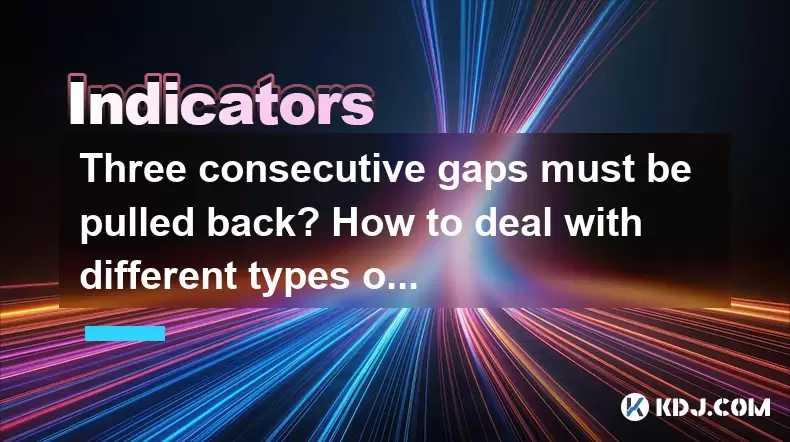
Understanding Gaps in Cryptocurrency Trading
In the world of cryptocurrency trading, price gaps are common occurrences due to the market's 24/7 nature. A gap refers to a situation where the price of an asset jumps from one level to another without any trading occurring in between. These gaps can appear on charts as empty spaces and often occur after significant news events, regulatory changes, or sudden shifts in market sentiment.
Gaps are typically categorized into four types: common gaps, breakaway gaps, runaway (measuring) gaps, and exhaustion gaps. Each type carries different implications for traders and investors. It is crucial to understand these distinctions to make informed decisions when facing multiple gaps in succession.
What Happens When Three Consecutive Gaps Appear?
When three consecutive gaps appear on a chart, especially within a short time frame, it raises questions about whether they will be pulled back or filled. The concept of a gap being "filled" means that the price eventually returns to the level before the gap occurred.
Three consecutive gaps may suggest strong momentum in one direction. However, this does not guarantee that all gaps must necessarily be pulled back. In fact, some gaps—especially breakaway gaps—are rarely filled because they signify the start of a new trend. Traders should evaluate each gap’s context rather than assuming automatic pullbacks.
How to Identify and Categorize Different Types of Gaps
To effectively handle gaps, it's essential to identify their type:
- Common Gaps: These are small gaps that occur frequently and usually get filled quickly. They lack significance and often appear in sideways markets.
- Breakaway Gaps: These signal the beginning of a new trend. They are accompanied by high volume and usually don’t get filled soon after formation.
- Runaway Gaps: Also known as measuring gaps, these occur midway through a trend and indicate continued momentum. They act as confirmation of the ongoing trend.
- Exhaustion Gaps: These appear near the end of a trend and often precede a reversal. They are usually followed by a rapid price movement in the opposite direction.
Identifying the gap type involves analyzing volume, price action, and market context. For example, if a gap appears after a long uptrend with unusually low volume, it might be an exhaustion gap.
Strategies for Dealing with Common Gaps
Common gaps are the easiest to trade since they tend to close relatively quickly. Here’s how you can approach them:
- Look for a gap that appears in a consolidation phase or during low volatility.
- Wait for the price to move back toward the gap area.
- Set a limit order near the gap zone to enter a position in the direction of the expected pullback.
- Place a stop-loss just beyond the gap to manage risk.
- Target the previous support or resistance level once the gap is filled.
Because these gaps are frequent and predictable, many traders use them for short-term scalping strategies.
Handling Breakaway and Runaway Gaps
Breakaway and runaway gaps are more complex and require a different strategy:
- After identifying a breakaway gap, consider entering a trade in the direction of the breakout.
- Use volume confirmation—if the gap occurs with a spike in volume, it strengthens the validity of the breakout.
- Place a stop-loss below the previous consolidation zone or key support level.
- For runaway gaps, look to add to existing positions or initiate new ones once the gap confirms continued momentum.
- Always monitor the distance traveled from the original breakout point; runaway gaps often appear halfway through a trend.
These types of gaps are not meant to be traded for immediate pullbacks but rather as opportunities to ride the emerging or continuing trend.
Managing Exhaustion Gaps and Avoiding False Signals
Exhaustion gaps can be deceptive. They often appear after extended moves and mimic runaway gaps but lead to reversals instead. To avoid false signals:
- Watch for signs of weakening momentum such as lower volume compared to earlier gaps.
- Observe candlestick patterns at the gap area—spinning tops or dojis can indicate indecision.
- Enter trades only after confirming the reversal with additional indicators like RSI or MACD.
- Consider using options or futures contracts to hedge against unexpected reversals triggered by exhaustion gaps.
Timing is critical when dealing with exhaustion gaps. Entering too early can result in losses, while waiting for confirmation may reduce profit potential.
Frequently Asked Questions
Q1: Can gaps in cryptocurrency markets be predicted?
While gaps cannot be predicted with certainty, traders can anticipate them by monitoring major news events, regulatory announcements, and macroeconomic factors that influence crypto prices.
Q2: Do all gaps eventually get filled?
No, not all gaps get filled. Breakaway and runaway gaps often remain unfilled, especially if they align with strong trends. Only common and exhaustion gaps are more likely to see price return to pre-gap levels.
Q3: Is it safe to trade gaps on low liquidity exchanges?
Trading gaps on low liquidity exchanges can be risky due to slippage and unreliable price data. It’s advisable to focus on major exchanges with higher trading volumes to ensure accurate execution and reliable gap identification.
Q4: How can I distinguish between a runaway gap and an exhaustion gap?
A runaway gap appears mid-trend with strong volume and supports continuation, while an exhaustion gap shows up at the end of a trend with weak volume and is often followed by a reversal.
Disclaimer:info@kdj.com
The information provided is not trading advice. kdj.com does not assume any responsibility for any investments made based on the information provided in this article. Cryptocurrencies are highly volatile and it is highly recommended that you invest with caution after thorough research!
If you believe that the content used on this website infringes your copyright, please contact us immediately (info@kdj.com) and we will delete it promptly.
- Dogecoin's Crossroads: Buy Signal or Risky Business?
- 2025-06-25 18:25:12
- Pi Network Price Prediction: Navigating the Coin's Breakout and Potential Drop
- 2025-06-25 18:25:12
- Green Minerals, Panther Metals, and the Bitcoin Buy-In: A New Era for Mining?
- 2025-06-25 18:35:13
- Shiba Inu, Dogecoin, and Meme Coins: What's the Hype in 2025?
- 2025-06-25 16:25:12
- JasmyCoin's Wild Ride: 6x Setup or Just a Mirage?
- 2025-06-25 16:25:12
- Mastercard's Stablecoin Integration: Revolutionizing On-Chain Commerce, NY Style
- 2025-06-25 16:45:12
Related knowledge
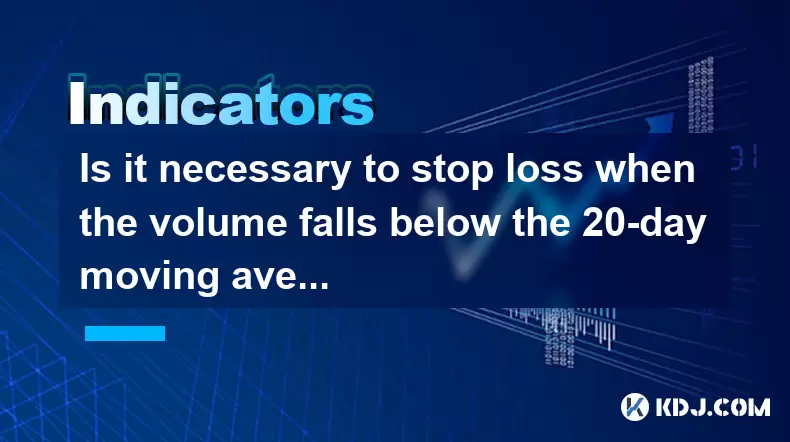
Is it necessary to stop loss when the volume falls below the 20-day moving average?
Jun 25,2025 at 05:00pm
Understanding the 20-Day Moving Average in Cryptocurrency TradingIn cryptocurrency trading, technical analysis plays a pivotal role in decision-making. One of the most commonly used indicators is the 20-day moving average (MA). This metric calculates the average price of an asset over the past 20 days and helps traders identify trends and potential reve...
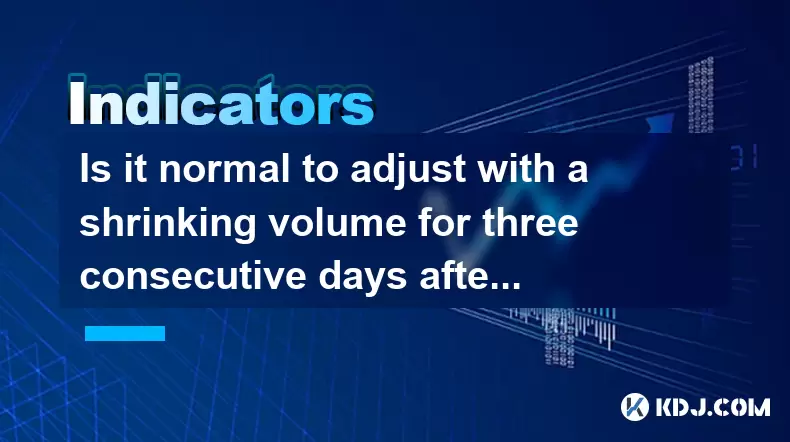
Is it normal to adjust with a shrinking volume for three consecutive days after breaking through the previous high with a large volume?
Jun 25,2025 at 03:49pm
Understanding Volume and Price Relationship in Cryptocurrency TradingIn cryptocurrency markets, volume is a critical metric that reflects the number of assets traded over a specific period. When a cryptocurrency breaks through a previous high with large volume, it typically signals strong buying pressure and market confidence. However, it's not uncommon...
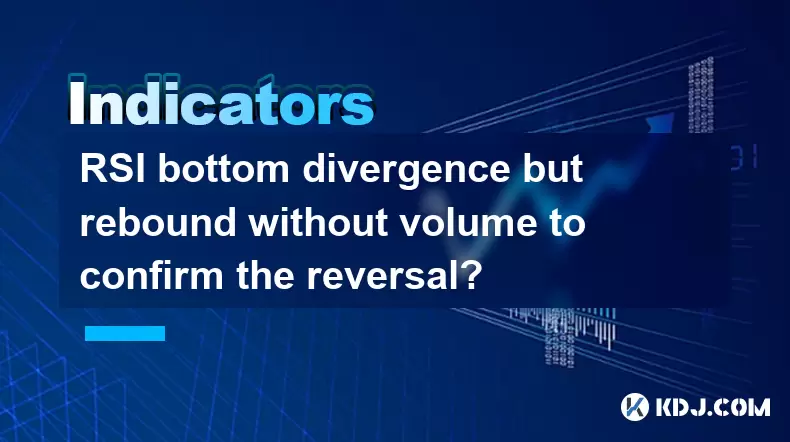
RSI bottom divergence but rebound without volume to confirm the reversal?
Jun 25,2025 at 04:42pm
Understanding RSI Bottom DivergenceRelative Strength Index (RSI) is a momentum oscillator used in technical analysis to measure the speed and change of price movements. RSI bottom divergence occurs when the price of an asset makes a new low, but the RSI does not confirm that low and instead forms a higher low. This pattern suggests weakening downward mo...
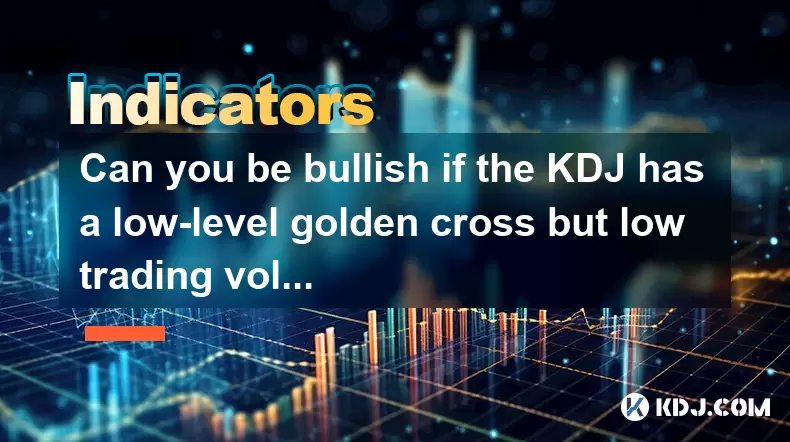
Can you be bullish if the KDJ has a low-level golden cross but low trading volume?
Jun 25,2025 at 03:14pm
Understanding the KDJ Indicator in Cryptocurrency TradingThe KDJ indicator, also known as the stochastic oscillator, is a momentum-based technical analysis tool widely used in cryptocurrency trading. It comprises three lines: the %K line (fast stochastic), the %D line (slow stochastic), and the J line (divergence value). These lines oscillate between 0 ...
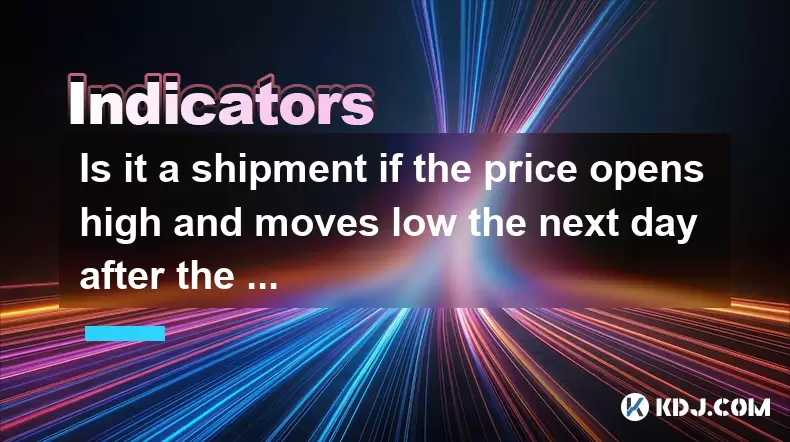
Is it a shipment if the price opens high and moves low the next day after the daily limit with huge volume?
Jun 25,2025 at 12:56pm
Understanding the Concept of a Shipment in Cryptocurrency TradingIn cryptocurrency trading, the term shipment refers to a scenario where large volumes of an asset are sold off rapidly, often leading to a significant price drop. This is typically associated with whale activity or coordinated selling by major holders. When traders observe certain patterns...
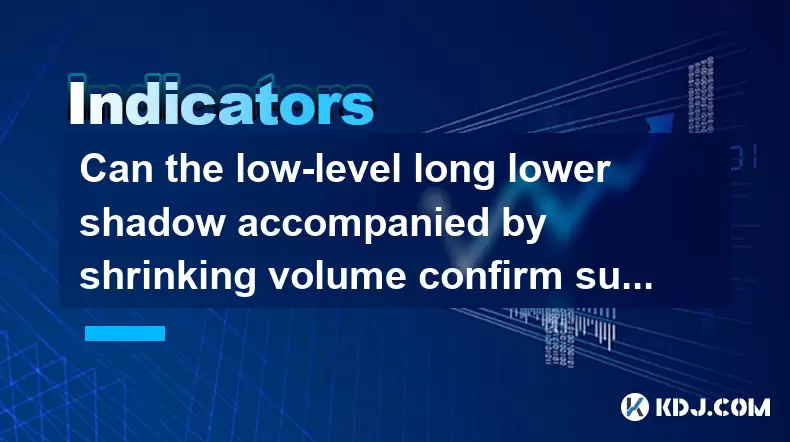
Can the low-level long lower shadow accompanied by shrinking volume confirm support?
Jun 25,2025 at 03:08pm
Understanding the Long Lower Shadow Candlestick PatternA long lower shadow candlestick pattern occurs when a candle closes near its high but has a significantly long lower wick, indicating that sellers pushed prices down during the session but were met with strong buying pressure that drove the price back up. This pattern is often seen as a potential si...

Is it necessary to stop loss when the volume falls below the 20-day moving average?
Jun 25,2025 at 05:00pm
Understanding the 20-Day Moving Average in Cryptocurrency TradingIn cryptocurrency trading, technical analysis plays a pivotal role in decision-making. One of the most commonly used indicators is the 20-day moving average (MA). This metric calculates the average price of an asset over the past 20 days and helps traders identify trends and potential reve...

Is it normal to adjust with a shrinking volume for three consecutive days after breaking through the previous high with a large volume?
Jun 25,2025 at 03:49pm
Understanding Volume and Price Relationship in Cryptocurrency TradingIn cryptocurrency markets, volume is a critical metric that reflects the number of assets traded over a specific period. When a cryptocurrency breaks through a previous high with large volume, it typically signals strong buying pressure and market confidence. However, it's not uncommon...

RSI bottom divergence but rebound without volume to confirm the reversal?
Jun 25,2025 at 04:42pm
Understanding RSI Bottom DivergenceRelative Strength Index (RSI) is a momentum oscillator used in technical analysis to measure the speed and change of price movements. RSI bottom divergence occurs when the price of an asset makes a new low, but the RSI does not confirm that low and instead forms a higher low. This pattern suggests weakening downward mo...

Can you be bullish if the KDJ has a low-level golden cross but low trading volume?
Jun 25,2025 at 03:14pm
Understanding the KDJ Indicator in Cryptocurrency TradingThe KDJ indicator, also known as the stochastic oscillator, is a momentum-based technical analysis tool widely used in cryptocurrency trading. It comprises three lines: the %K line (fast stochastic), the %D line (slow stochastic), and the J line (divergence value). These lines oscillate between 0 ...

Is it a shipment if the price opens high and moves low the next day after the daily limit with huge volume?
Jun 25,2025 at 12:56pm
Understanding the Concept of a Shipment in Cryptocurrency TradingIn cryptocurrency trading, the term shipment refers to a scenario where large volumes of an asset are sold off rapidly, often leading to a significant price drop. This is typically associated with whale activity or coordinated selling by major holders. When traders observe certain patterns...

Can the low-level long lower shadow accompanied by shrinking volume confirm support?
Jun 25,2025 at 03:08pm
Understanding the Long Lower Shadow Candlestick PatternA long lower shadow candlestick pattern occurs when a candle closes near its high but has a significantly long lower wick, indicating that sellers pushed prices down during the session but were met with strong buying pressure that drove the price back up. This pattern is often seen as a potential si...
See all articles























































































